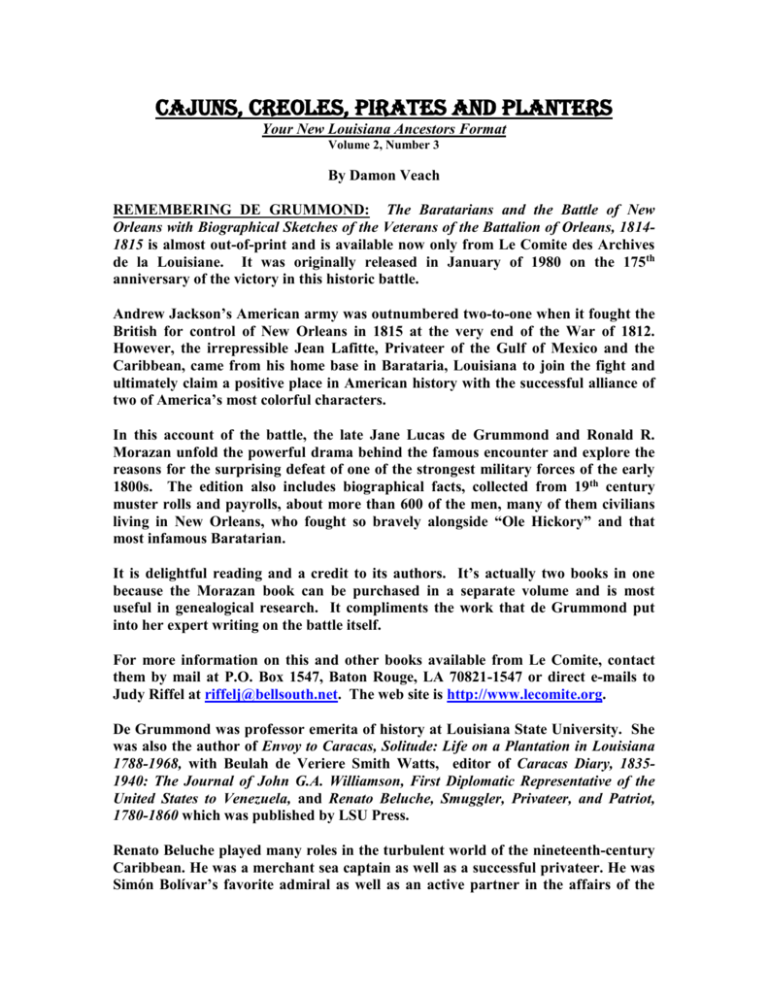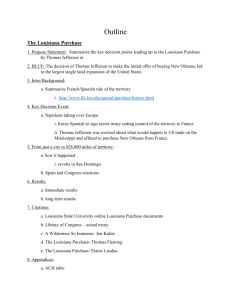CAJUNS, CREOLES, PIRATES AND PLANTERS
advertisement

CAJUNS, CREOLES, PIRATES AND PLANTERS Your New Louisiana Ancestors Format Volume 2, Number 3 By Damon Veach REMEMBERING DE GRUMMOND: The Baratarians and the Battle of New Orleans with Biographical Sketches of the Veterans of the Battalion of Orleans, 18141815 is almost out-of-print and is available now only from Le Comite des Archives de la Louisiane. It was originally released in January of 1980 on the 175th anniversary of the victory in this historic battle. Andrew Jackson’s American army was outnumbered two-to-one when it fought the British for control of New Orleans in 1815 at the very end of the War of 1812. However, the irrepressible Jean Lafitte, Privateer of the Gulf of Mexico and the Caribbean, came from his home base in Barataria, Louisiana to join the fight and ultimately claim a positive place in American history with the successful alliance of two of America’s most colorful characters. In this account of the battle, the late Jane Lucas de Grummond and Ronald R. Morazan unfold the powerful drama behind the famous encounter and explore the reasons for the surprising defeat of one of the strongest military forces of the early 1800s. The edition also includes biographical facts, collected from 19th century muster rolls and payrolls, about more than 600 of the men, many of them civilians living in New Orleans, who fought so bravely alongside “Ole Hickory” and that most infamous Baratarian. It is delightful reading and a credit to its authors. It’s actually two books in one because the Morazan book can be purchased in a separate volume and is most useful in genealogical research. It compliments the work that de Grummond put into her expert writing on the battle itself. For more information on this and other books available from Le Comite, contact them by mail at P.O. Box 1547, Baton Rouge, LA 70821-1547 or direct e-mails to Judy Riffel at riffelj@bellsouth.net. The web site is http://www.lecomite.org. De Grummond was professor emerita of history at Louisiana State University. She was also the author of Envoy to Caracas, Solitude: Life on a Plantation in Louisiana 1788-1968, with Beulah de Veriere Smith Watts, editor of Caracas Diary, 18351940: The Journal of John G.A. Williamson, First Diplomatic Representative of the United States to Venezuela, and Renato Beluche, Smuggler, Privateer, and Patriot, 1780-1860 which was published by LSU Press. Renato Beluche played many roles in the turbulent world of the nineteenth-century Caribbean. He was a merchant sea captain as well as a successful privateer. He was Simón Bolívar’s favorite admiral as well as an active partner in the affairs of the Laffite brothers. He fought both as a revolutionary and as a defender against revolt. He was a patriot in the eyes of eight American nations and a brigand in the eyes of England and France. In tracing the course of Beluche’s chameleonlike career, this biography gives a panoramic view of the complex affairs of the Caribbean during one of the most volatile periods in its history. Beluche is the product of the more than forty years that De Grummond devoted to the history of the United States, the Louisiana Gulf Coast, and Latin America. It draws together her knowledge not only of Beluche’s exploits but also of the wars, revolutions, and treacherous allegiances that shaped the development of the Caribbean. Renato Beluche was born in New Orleans in 1780, the son of a recently emigrated Frenchman whose wig-making business was a front for smuggling. In 1802, Beluche went to sea as a pilot’s mate on the flagship of the Spanish fleet, and by 1805 he was master of a merchant schooner. By this time, the Lafitte brothers had established a smuggling base at Grande Terre on the Louisiana coast. Flying the French flag, Beluche captured Spanish and English ships and sent them to Grande Terre, Cartagena, and New Granada. If you enjoyed de Grummond’s book on Lafitte and the Baratarians, you will also want to add this one to your collection. The author was a friend of mine and a very talented author who contributed so much to this period of American history. XXX CANCIENNE CONNECTION: Thomas Cancienne of Company B, 26th Louisiana Regiment, Confederate States of America, was paroled July 7, 1863 in Vicksburg, Mississippi by order of Captain Sam Roper, 56th Regiment, Illinois Infantry, after giving his solemn oath not to take arms against the United States. Cancienne was not unique in this respect. Hundreds of other former Confederate soldiers were paroled on the same day after taking the same oath. Cancienne, however, did not return to his home on the bayous in Lafourche Parish, but instead he made his way somehow to Veracruz, Mexico, and later to San Rafael, 80 miles north of Veracruz. San Rafael, with its endless fields of sugarcane and its hot tropical climate, must have been reminiscent of Lafourche Parish and Napoleonville in particular. He remained in San Rafael and reared a family of 14 children. Many of Thomas’ children spoke a strange dialect of French as well as Spanish. Thomas Cancienne was a son of Pierre Cancienne of Napoleonville, and one of the descendants of Pierre Cancienne who married Margueritte Landry in Donaldsonville on February 15, 1786. The marriage certificate of Pierre and Margueritte (with spellings Pedro Cansiani and Margarita Landri) lists Pierre’s birthplace as Venice, which later became part of Italy in 1866. The only known Louisiana Cancienne to communicate with Thomas Cancienne in Mexico was Rudolf Cancienne, formerly employed as commercial accounts manager for South Central Bell in New Orleans. Rudolf died on November 20, 1972. Acelia Cancienne of Veracruz managed to re-establish contact with her Louisiana cousins in May of 1972, but she did not contact Rudolf Cancienne prior to his death. Rudolf Cancienne never married and left no known relatives who may know more of the Mexican lineage. At last report, the Cancienne family was still trying to piece together the history of their family. XXX EXCELLENT PUBLICATION: The latest issue of “Kinfolks,” the official publication of the Southwest Louisiana Genealogical Society is once again filled with excellent research material about this section of Louisiana. Much discussion was given to their November program which covered the 1940s Louisiana Maneuvers with a separate section on World War II Trivia. One of the more interesting articles original appeared in the Cameron Parish Pilot and was about Belle Boyd, a southern spy. Haiti also was an interesting read and contributed by Rosie Newhouse. This group of hard-working researchers always comes up with interesting points of discussion in their quarterly publication. There is always so much material to peruse, and the content is very broad in coverage. Other items in this issue covered Cameron, Grand Chenier, and Little Chenier cemeteries, the 1911 Lake Charles City Directory, the ancestor chart for Edward Sherman Young, a query section, index, and many more miscellaneous notes. Membership in this society is $12 for individuals and $17 for families (husband and wife), and they also have several publication and compilations of records for sale. For more information, contact them at P.O. Box 5652, Lake Charles, LA 706065652. They are online at http://www.rootsweb.ancestry.com/~laslgs/swlgs.htm. Their last meeting covered the many cultures of French Louisiana.









